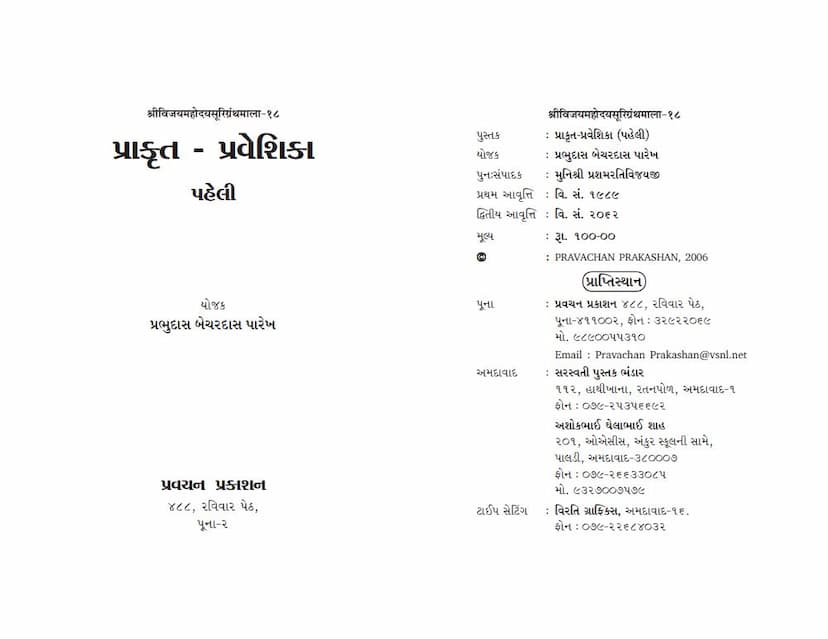Prakrit Praveshika 1
Added to library: September 2, 2025
Loading image...

Summary
The book "Prakrit Praveshika 1" by Prabhudas Bechardas Parekh and Prashamrativijay, published by Pravachan Prakashan Pune, is a foundational text designed to introduce learners to the Prakrit language. It aims to make the study of Prakrit accessible and engaging, particularly for those familiar with Gujarati.
Key aspects and goals of the book:
- Bridging the Gap: The book acknowledges the widespread study of Sanskrit in India but notes a decline in the momentum of learning Prakrit. This has created difficulties for scholars and sadhus when encountering Prakrit texts, leading to a need for a dedicated introductory resource.
- Target Audience: While aimed at a general audience, the book specifically considers Gujarati speakers, incorporating Gujarati words and grammatical structures where appropriate to ease the learning process.
- Methodology:
- Gradual Progression: The content is structured to move from simple topics to more complex ones, ensuring a smooth learning curve.
- Direct Connection: Each topic begins with simple Prakrit sentences to establish a direct link between the language and the learner's mind.
- Explanations and Examples: Following the sentences, grammatical rules, derived forms, and examples are provided.
- Reinforcement: Both Prakrit and Gujarati sentences are included for practice and examination, reinforcing the learned concepts through varied presentation.
- Focus on Gujarati Usage: The compilation prioritizes Prakrit words commonly used in Gujarati or closely related to it, reducing the burden of memorizing an unfamiliar vocabulary.
- Clarity and Precision: Efforts are made to ensure the explanations of forms and usages are clear and unambiguous, especially addressing the multiplicity of forms in Prakrit.
- Detailed Morphology: Extensive verb and noun conjugation tables (rupavali) are provided for clarity and memorization, even if it increases the book's size.
- Grammatical Explanations: Basic grammatical terminologies and rules are explained contextually within the lessons.
- Content Structure:
- The book meticulously organizes its content, introducing basic subjects first and gradually progressing to more challenging ones.
- It emphasizes building a direct relationship with the language by presenting simple sentences before delving into detailed explanations of grammar, rules, and derived forms.
- The text aims for a thorough introduction by presenting the same subject matter in different ways, facilitating deeper understanding and retention.
- It includes exercises designed not just for testing but for progressive learning, allowing students to easily master the material.
- The approach is to build upon the familiar (Gujarati) to introduce the unfamiliar (Prakrit), simplifying the learning of Sanskrit-derived words and their Prakrit transformations.
- Particular attention is paid to making the forms and their usage clear, acknowledging that Prakrit's often numerous variations can be daunting for students.
- The book uses examples and sentences selected from ancient literature where possible, but also includes self-created simple sentences for introductory lessons, as finding suitable ancient examples for beginners is challenging.
- It incorporates small narratives and engaging anecdotes from ancient literature in later sections.
- The structure follows a pattern of language introduction, followed by grammatical analysis, forms, and vocabulary, aiming for a comprehensive grasp of both the language and its structure.
- Emphasis is placed on memorizing word and verb conjugations and a glossary for easier entry into literature.
- The book also provides brief explanations of grammar terminology and study methods.
- Key grammatical concepts like compound words (samasa) and participles (kridanta) are introduced early and explained in a simplified manner.
- The complex topic of phonetic changes (akshara-parivartan) is handled by first presenting an overview of types, then providing concise yet clear explanations of each, aiming for both comprehension and breadth of coverage with minimal rules.
- Numerical words are explained in detail, with a systematic approach to pronoun conjugations to ease their complexity.
- Useful indeclinables (avyaya) and derivative suffixes (taddhita) are included.
- Miscellaneous topics related to Prakrit, such as archaic usage (arsha prayoga), variation (bahulana), local usage (deshya prayoga), gender variations, and Prakrit prosody (chandas) are covered.
- An appendix provides Prakrit prose and poetry samples with annotations for difficult words and usages, along with a glossary of commonly known words and Prakrit adaptations of Sanskrit verb roots.
Editorial Context:
- The book is presented as the 18th publication in the Shri Vinaymoye Suri Granthamala, dedicated to making rare texts accessible.
- It acknowledges the inspiration from Acharya Shrimad Vijayramchandrasurishwarji Maharaj and the efforts of Muni Shree Vairagyaratitivijayji M. and Muni Shree Prashamrativijayji.
- The publication was made possible through the support of the Deesa Shwetamber Murtipujak Jain Sangh Pedhi and the Shri Rajpur Jain Shwetamber Murtipujak Sangh.
Challenges and Aspirations:
- The author, Prabhudas Bechardas Parekh, acknowledges potential shortcomings in the initial draft, including the loss of half of the manuscript during travel, which necessitated re-compilation and might have led to some organizational flaws. Typographical errors are also admitted due to visual defects and typesetting issues.
- The author expresses hope for improvement in future editions, especially with feedback from teachers and students.
- A significant challenge mentioned is the rarity of Prakrit literature, forcing the reliance on only a few texts for building the entire grammatical framework, which might have led to some inaccuracies.
- Despite the perceived imperfections of the first edition, the author hopes it will be a valuable resource for Prakrit enthusiasts, students, and educators.
Overall, "Prakrit Praveshika 1" is a comprehensive and systematic guide intended to serve as an accessible entry point into the study of Prakrit, particularly emphasizing clarity, gradual learning, and a connection to the Gujarati linguistic context.